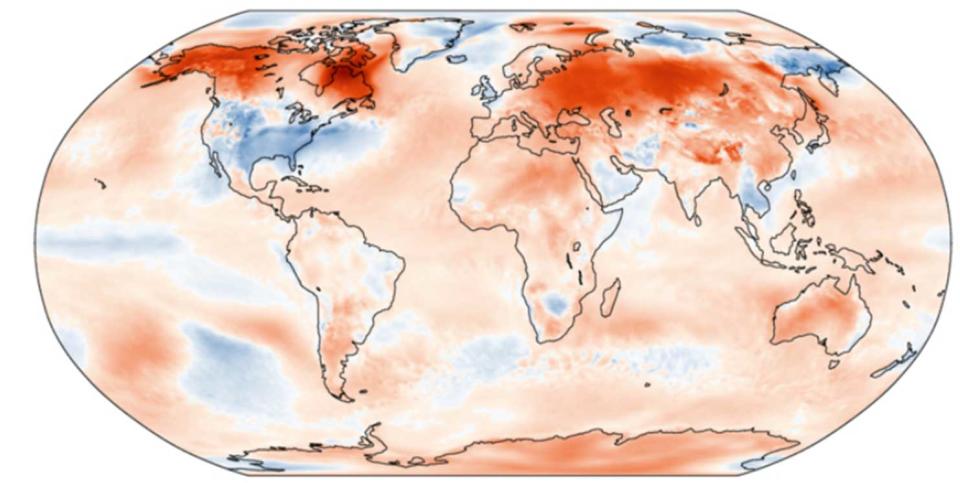The UK was cooler than average last month, despite it unexpectedly being the hottest January on record around the world.
Scientists had expected temperatures to be cooler around the globe, due to an emerging La Nina weather pattern that cools global temperatures.
However, this January’s temperatures broke records by being 0.79C above the 1991-2020 global average for the month and 1.75C above pre-industrial levels, according to scientists from the EU’s Copernicus Climate Change Service (C3S).
Trusted news and daily delights, right in your inbox
See for yourself — The Yodel is the go-to source for daily news, entertainment and feel-good stories.
Despite this, some European countries – including the UK, had lower temperatures than average.
Why was the UK average cooler?
Surface air temperatures for January 2025 relative to the January average for the period 1991-2020. (C3S/ECMWF)
Copernicus’s figures use billions of measurements from satellites, ships, aircraft and weather stations around the world.
Most places in the world were warmer, but areas including the UK and Ireland, Iceland, northern France and northern Scandinavia were cooler than average.
A Met Office spokesman told Yahoo News: “While January global temperature records were broken according to Copernicus, it was a cooler than average month for the UK according to provisional Met Office figures.
“The figures from Copernicus obviously take into account the global temperatures, so it’s not surprising that some parts of the world will still see below average temperatures, even as global temperatures break records.”
How will climate change affect the UK?
The figure for January was cooler than average, but it’s important to remember that this temperature is an average compared to the period covering 1991-2020. It doesn’t mean the UK is cooler than before.
“It’s interesting to note that while the UK’s January was cooler than average compared to the most recent 30-year meteorological averaging period, it would have been considered as average when compared to the 1961-1990 averaging period,” the Met Office said.
“That shift in the long-term average is consistent with global patterns as a result of human-induced climate change.”
What does this mean? In the UK, winters are projected to generally become warmer and wetter on average, while summers will likely become hotter and drier.
Extreme weather events will likely occur more frequently due to climate change. (Reuters)
By 2050, heatwaves are expected to happen every other year. And by 2070, the Met Office predicts that:
-
Winters will be between 1-4.5C warmer and up to 30% wetter
-
Summers will be between 1-6C warmer and up to 60% drier
In addition, sea levels around the UK will continue to rise, meaning low-lying areas and coastal urban areas will be more prone to flooding.
Extreme weather events will likely occur more frequently, meaning greater damage to buildings and infrastructure from flooding, storms and heat.
Scientists at Berkeley Earth and the UK Met Office have said they expect 2025 to be the third-warmest year on record – cooler than 2024 and 2023 because of the shift towards La Nina, though uncertainties remain about how the phenomenon will develop.
Why were scientists surprised by January’s temperatures?
The record highs come despite the emergence in the Pacific of the La Nina pattern, which generally cools global temperatures.
Sea surface temperatures outside the polar regions averaged 20.78C, making it the second hottest January after last year’s record.
Temperatures were below average in the central Pacific but close to or above average in the eastern Pacific – suggesting a slowing or stalling of the move to La Nina conditions, while sea surface temperatures were unusually high in many other oceans and seas.
The average temperature over land in Europe was 1.8C, which is some 2.51C above the 1991-2020 average for January, making it the second warmest January for the continent after 2020.
Samantha Burgess, strategic lead for climate at the European Centre for Medium-Range Weather Forecasts which runs C3S, said: “January 2025 is another surprising month, continuing the record temperatures observed throughout the last two years, despite the development of La Nina conditions in the tropical Pacific and their temporary cooling effect on global temperatures.
And even if La Nina does fully emerge, Burgess said its cooling effect may not be enough to temporarily curb global temperatures – which are also affected by factors like the extreme heat seen in other ocean basins, and the main driver of climate change: emissions of heat-trapping greenhouse gases.
Read more
#cooler #normal #January #global #temperatures #hit #record #high












Leave a Reply